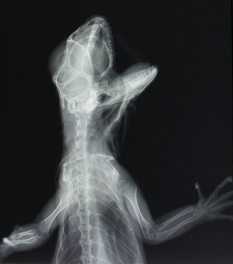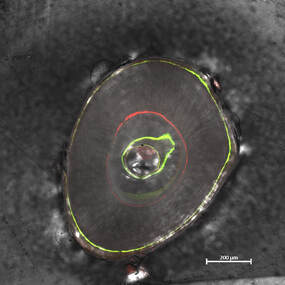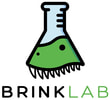
Research: The Ecology and Evolution of Biomineralized Tissues
The evolution of bones and teeth is an adaptive breakthrough that led to the radiation of vertebrate animals. Not only do they provide support, energy, and increase functional capability, bones and teeth also capture a record of an animal’s life history through the formation of growth marks and changes in chemical composition during biomineralization. This record is used to infer life history traits such as growth rates, time of reproduction, and survivorship, and ecological traits such as dietary preference and trophic levels in food webs. Fortuitously, this record can also be captured in fossilized remains, thereby allowing for an interpretation of life history traits and ecology in extinct animals based on patterns in living animals. However, the microanatomical structure of these growth marks and their formation and variation in living animals is not fully understood, especially how environmental factors like seasonality and limited resources impact biomineralization.
The evolution of bones and teeth is an adaptive breakthrough that led to the radiation of vertebrate animals. Not only do they provide support, energy, and increase functional capability, bones and teeth also capture a record of an animal’s life history through the formation of growth marks and changes in chemical composition during biomineralization. This record is used to infer life history traits such as growth rates, time of reproduction, and survivorship, and ecological traits such as dietary preference and trophic levels in food webs. Fortuitously, this record can also be captured in fossilized remains, thereby allowing for an interpretation of life history traits and ecology in extinct animals based on patterns in living animals. However, the microanatomical structure of these growth marks and their formation and variation in living animals is not fully understood, especially how environmental factors like seasonality and limited resources impact biomineralization.

The longterm objective of this research program is to integrate data from the fields of paleontology, evolutionary developmental biology (EvoDevo), ecology, and geology to interpret the life history and ecological niche of extinct vertebrates through examination of bone and tooth ultrastructure. Different types of imaging and microscopy will be used, including computed tomography and optical microscopy, with a relatively new approach to studying vertebrate fossils at the nanoscale using transmission electron microscopy. Detailed characterization of growth marks in biomineralized tissues from the macro to the nanoscale in living fish from Manitoba and reptiles (leopard geckos and brown anoles) will elucidate how these structures form, the rate at which they form, and under what conditions. Only then, armed with the information gathered from living animals, can meaningful interpretations of extinct animal ecology from fossilized growth marks be undertaken. Furthermore, analyzing the chemical composition of the biomineralized tissue in living animals is paramount to separating biological chemical signatures from diagenetic signatures in fossil material. Data collected from individuals can then be examined in a comparative context over long, million-year timescales to determine relationships between vertebrate life history and environmental change in deep time.
Publications:
32. Brink, Kirstin S. and LeBlanc A.R.H. 2023. How the study of crocodylian teeth influences our understanding of dental development, replacement, and evolution in dinosaurs. Chapter 12 in: Ruling Reptiles: Crocodylian Biology and Archosaur Paleobiology. Eds: H. Woodward and J. Farlow. Indiana University Press.
31. Theropod dinosaur facial reconstruction and the importance of soft tissues in paleobiology.
TM Cullen, DW Larson, MP Witton, D Scott, T Maho, KS Brink, DC Evans, RR Reisz. Science 379 (6639), 1348-1352. DOI:10.1126/science.abo7877
30. Takasaki, Ryuji, Kentaro Chiba, Anthony R. Fiorillo, Kirstin S. Brink, David C. Evans, Federico Fanti, Mototaka Saneyoshi, Anthony Maltese, and Shinobu Ishigaki. 2022. Description of the first definitive Corythosaurus (Dinosauria: Hadrosauridae) specimens from the Judith River Formation in Montana, USA and their paleobiogeographical significance. Anatomical Record. https://doi.org/10.1002/ar.25097
29. Kilmury, A. A., and K. S. Brink. 2022. Late Cretaceous vertebrate faunal assemblages of the Manitoba escarpment, Canada: Implications for Western Interior Seaway provinciality and biodiversity. Palaeogeography, Palaeoclimatology, Palaeoecology:https://doi.org/10.1016/j.palaeo.2022.111119.
28. Kilmury, A.A.; M.P.B. Nicolas, and Kirstin S. Brink. 2021. Identifying Late Cretaceous vertebrate fossil collection biases, southwestern Manitoba and east-central Saskatchewan. in: Report of Activities 2021, Manitoba Agriculture and Resource Development, Manitoba Geological Survey, p.59-65. www.manitoba.ca/iem/geo/field/roa21pdfs/GS2021-6.pdf
27. Cullen, Thomas; Caleb M. Brown, Kentaro Chiba, Kirstin S. Brink, Peter Makovicky, and David C. Evans. 2021. Growth variability, dimensional scaling, and the interpretation of osteohistological growth data. Biology Letters https://doi.org/10.1098/rsbl.2021.0383
26. Brink, Kirstin S., TM Grieco, J Henríquez, JRM del Campo, K Fu, and JM Richman. 2021. Tooth removal in the leopard gecko and the de novo formation of replacement teeth. Frontiers in Physiology.
https://www.frontiersin.org/articles/10.3389/fphys.2021.576816/full
25. Whitney, Megan R; A.R.H. LeBlanc, A.R. Reynolds, and K.S. Brink. 2020. Convergent dental adaptations in the serrations of hypercarnivorous synapsids and dinosaurs. Biology Letters. https://doi.org/10.1098/rsbl.2020.0750
24. Brink, Kirstin S., Ping Wu, Cheng-Ming Chuong, and Joy M. Richman. 2020. The effects of premature tooth extraction and damage on replacement timing in the green iguana. Integrative and Comparative Biology DOI:10.1093/icb/icaa1099.
23. Brink, Kirstin S., Mark MacDougall and Robert Reisz. 2019. Dimetrodon (Synapsida:
Sphenacodontidae) from the cave system at Richards Spur, OK, USA, and a comparison of Early Permian-aged vertebrate paleoassemblages. Naturwissenschaften (The Science of Nature) doi.org/10.1007/s00114-018-1598-1
22. LeBlanc, A.R.H., Kirstin S. Brink, Megan R. Whitney, Fernando Abdala, and Robert R. Reisz. 2018. Dental ontogeny in extinct synapsids reveals a complex evolutionary history of the mammalian tooth attachment system. Proceedings of the Royal Society B 285(20181792): 1-9. doi: http://dx.doi.org/10.1098/rspb.2018.1792.
21. LeBlanc, Aaron R.H., Kirstin S. Brink, Thomas M. Cullen, and Robert R Reisz. 2017. Evolutionary implications of tooth attachment versus tooth implantation: a case study using dinosaur, crocodilian, and mammal teeth. Journal of Vertebrate Paleontology. http://dx.doi.org/10.1080/02724634.2017.1354006
20. Brocklehurst, N., and Brink, K.S. 2017. Selection towards larger body size in both herbivorous and carnivorous synapsids during the Carboniferous. FACETS 2: 68. doi.org/10.1139/facets-2016-0046
19. Brink, K.S., Chen, Y.-C., Wu, Y.-N., Liu, W.-M., Shieh, D.-B., Huang, T.D., Sun, C.-K., and Reisz, R.R. 2016. Dietary adaptions in the ultrastructure of dinosaur dentine. Journal of The Royal Society Interface 13(125): 20160626. DOI: 10.1098/rsif.2016.0626
18. Feng, R., Maley, J.M., Schatte, G., Hoffmeyer, R.E., Brink, K.S., Ellis, T., Brinkman, D., and Sammynaiken, R. 2016. Chemical and Structural Information from the Enamel of a Troodon Tooth Leading to an Understanding of Diet and Environment. Applied Spectroscopy. doi: 10.1177/0003702816653123.
17. Aaron RH LeBlanc, Robert R Reisz, Kirstin S Brink, Fernando Abdala. 2016. Mineralized periodontia in extinct relatives of mammals shed light on the evolutionary history of mineral homeostasis in periodontal tissue maintenance. Journal of Clinical Periodontology, DOI: 10.1111/jcpe.12508.
16. Brink, K.S. 2015. Case 3695: Dimetrodon Cope, 1878 (Synapsida, SPHENACODONTIDAE): proposed conservation by reversal of precedence with Bathygnathus Leidy, 1853. Bulletin of Zoological Nomenclature, vol. 72, no. 4, pp. 297-299.
15. Brink, K.S., H. C. Maddin, D. C. Evans, and R. R. Reisz. 2015. Re-evaluation of the historic Canadian fossil Bathygnathus borealis from the Early Permian of Prince Edward Island. Canadian Journal of Earth Sciences:1-12. http://www.nrcresearchpress.com/doi/full/10.1139/cjes-2015-0100
14. Brink, K.S., Reisz, R.R., LeBlanc, A.R.H., Chang, R.S., Lee, Y.C., Chiang, C.C., Huang, T., and Evans, D.C. 2015. Developmental and evolutionary novelty in the serrated teeth of theropod dinosaurs. Scientific Reports 5. doi: 10.1038/srep12338.
13. Chen, Y.-C., S.-Y. Lee, Y. Wu, K. Brink, D.-B. Shieh, T. D. Huang, R. R. Reisz, and C.-K. Sun. 2015. Third-harmonic generation microscopy reveals dental anatomy in ancient fossils. Optics Letters 40:1354-1357.
12. Caleb Marshall Brown, Collin S. VanBuren, Derek W. Larson, Kirstin S. Brink, Nicolás E. Campione, Matthew J. Vavrek, and David C. Evans. 2015. Tooth counts through growth in diapsid reptiles: implications for interpreting individual and size-related variation in the fossil record. Journal of Anatomy. DOI: 10.1111/joa.12280
11. Evans, D. C., P. M. Barrett, K. S. Brink, and M. T. Carrano. 2015. Osteology and bone microstructure of new, small theropod dinosaur material from the early Late Cretaceous of Morocco. Gondwana Research 27:1034-1041. doi:10.1016/j.gr.2014.03.016
10. Brink K. S., LeBlanc AH, Reisz R. 2014. First record of plicidentine in Synapsida and patterns of tooth root shape change in Early Permian sphenacodontians. Naturwissenschaften 101(11):883-92. doi: 10.1007/s00114-014-1228-5
9. Brink, K.S. and R. R. Reisz. Hidden dental diversity in the oldest terrestrial apex predator Dimetrodon. 2014. Nature Communications. http://www.nature.com/ncomms/2014/140207/ncomms4269/full/ncomms4269.html.
8. Brink, K.S., D. K. Zelenitsky, D. C. Evans, François Therrien, J. R. Horner. 2014. Cranial morphology and variation in Hypacrosaurus stebingeri (Ornithischia: Hadrosauridae). in: Hadrosaurs, eds David A. Eberth and David C. Evans.
7. K.S. Brink, N.E. Campione, and J.R. Hawthorn. 2013. Amniote faunal revision of the Pictou Group (Permo-Carboniferous), Prince Edward Island, Canada. Comptes Rendus Palevol. http://dx.doi.org/10.1016/j.crpv.2013.05.002
6. Bell, Phil R. and K.S. Brink. 2013. Kazaklambia convincens comb. nov., a primitive juvenile lambeosaurine from the Santonian of Kazakhstan. Cretaceous Research. http://dx.doi.org/10.1016/j.cretres.2013.05.003
5. Campione, N.E., K.S. Brink, E.A. Freedman, C.T McGarrity, and D.C. Evans. 2013. ‘Glishades ericksoni’, an indeterminate juvenile hadrosaurid from the Two Medicine Formation of Montana: implications for hadrosauroid diversity in the latest Cretaceous (Campanian-Maastrichtian) of western North America. Palaeobiodiversity and Palaeoenvironments 93(1): 65-75. DOI 10.1007/s12549-012-0097-1.
4. Brink, K.S., R.R. Reisz. 2012. Morphology of the palate and braincase of Dimetrodon milleri. Historical Biology 24(5):453-459. DOI 10.1080/08912963.2012.704918
3. Brink, K.S., J.R. Hawthorn, D.C. Evans. 2012. New occurrences of Ichniotherium and Striatichnium from the Lower Permian Kildare Capes Formation, Prince Edward Island, Canada: Palaeonenvironmental and biostratigraphic implications. Palaeontology 55(5):1075-1090. doi:10.1111/j.1475-4983.2012.01178.x
2. Brink, K.S., D. K. Zelenitsky, D. C. Evans, François Therrien, J. R. Horner. 2011. A sub-adult skull of Hypacrosaurus stebingeri (Ornithischia: Lambeosaurinae): Anatomy and Comparison. Historical Biology 23(1):63-72 DOI:10.1080/08912963.2010.499169
1. Brink, K. S., R. A. Stockey, G. Beard, and W. C. Wehr. 2009. Cunninghamia hornbyensis sp. nov.: Permineralized twigs and leaves from the Upper Cretaceous of Hornby Island, British Columbia, Canada. Review of Palaeobotany and Palynology 155(1-2):89-98. http://dx.doi.org/10.1016/j.revpalbo.2009.03.005
32. Brink, Kirstin S. and LeBlanc A.R.H. 2023. How the study of crocodylian teeth influences our understanding of dental development, replacement, and evolution in dinosaurs. Chapter 12 in: Ruling Reptiles: Crocodylian Biology and Archosaur Paleobiology. Eds: H. Woodward and J. Farlow. Indiana University Press.
31. Theropod dinosaur facial reconstruction and the importance of soft tissues in paleobiology.
TM Cullen, DW Larson, MP Witton, D Scott, T Maho, KS Brink, DC Evans, RR Reisz. Science 379 (6639), 1348-1352. DOI:10.1126/science.abo7877
30. Takasaki, Ryuji, Kentaro Chiba, Anthony R. Fiorillo, Kirstin S. Brink, David C. Evans, Federico Fanti, Mototaka Saneyoshi, Anthony Maltese, and Shinobu Ishigaki. 2022. Description of the first definitive Corythosaurus (Dinosauria: Hadrosauridae) specimens from the Judith River Formation in Montana, USA and their paleobiogeographical significance. Anatomical Record. https://doi.org/10.1002/ar.25097
29. Kilmury, A. A., and K. S. Brink. 2022. Late Cretaceous vertebrate faunal assemblages of the Manitoba escarpment, Canada: Implications for Western Interior Seaway provinciality and biodiversity. Palaeogeography, Palaeoclimatology, Palaeoecology:https://doi.org/10.1016/j.palaeo.2022.111119.
28. Kilmury, A.A.; M.P.B. Nicolas, and Kirstin S. Brink. 2021. Identifying Late Cretaceous vertebrate fossil collection biases, southwestern Manitoba and east-central Saskatchewan. in: Report of Activities 2021, Manitoba Agriculture and Resource Development, Manitoba Geological Survey, p.59-65. www.manitoba.ca/iem/geo/field/roa21pdfs/GS2021-6.pdf
27. Cullen, Thomas; Caleb M. Brown, Kentaro Chiba, Kirstin S. Brink, Peter Makovicky, and David C. Evans. 2021. Growth variability, dimensional scaling, and the interpretation of osteohistological growth data. Biology Letters https://doi.org/10.1098/rsbl.2021.0383
26. Brink, Kirstin S., TM Grieco, J Henríquez, JRM del Campo, K Fu, and JM Richman. 2021. Tooth removal in the leopard gecko and the de novo formation of replacement teeth. Frontiers in Physiology.
https://www.frontiersin.org/articles/10.3389/fphys.2021.576816/full
25. Whitney, Megan R; A.R.H. LeBlanc, A.R. Reynolds, and K.S. Brink. 2020. Convergent dental adaptations in the serrations of hypercarnivorous synapsids and dinosaurs. Biology Letters. https://doi.org/10.1098/rsbl.2020.0750
24. Brink, Kirstin S., Ping Wu, Cheng-Ming Chuong, and Joy M. Richman. 2020. The effects of premature tooth extraction and damage on replacement timing in the green iguana. Integrative and Comparative Biology DOI:10.1093/icb/icaa1099.
23. Brink, Kirstin S., Mark MacDougall and Robert Reisz. 2019. Dimetrodon (Synapsida:
Sphenacodontidae) from the cave system at Richards Spur, OK, USA, and a comparison of Early Permian-aged vertebrate paleoassemblages. Naturwissenschaften (The Science of Nature) doi.org/10.1007/s00114-018-1598-1
22. LeBlanc, A.R.H., Kirstin S. Brink, Megan R. Whitney, Fernando Abdala, and Robert R. Reisz. 2018. Dental ontogeny in extinct synapsids reveals a complex evolutionary history of the mammalian tooth attachment system. Proceedings of the Royal Society B 285(20181792): 1-9. doi: http://dx.doi.org/10.1098/rspb.2018.1792.
21. LeBlanc, Aaron R.H., Kirstin S. Brink, Thomas M. Cullen, and Robert R Reisz. 2017. Evolutionary implications of tooth attachment versus tooth implantation: a case study using dinosaur, crocodilian, and mammal teeth. Journal of Vertebrate Paleontology. http://dx.doi.org/10.1080/02724634.2017.1354006
20. Brocklehurst, N., and Brink, K.S. 2017. Selection towards larger body size in both herbivorous and carnivorous synapsids during the Carboniferous. FACETS 2: 68. doi.org/10.1139/facets-2016-0046
19. Brink, K.S., Chen, Y.-C., Wu, Y.-N., Liu, W.-M., Shieh, D.-B., Huang, T.D., Sun, C.-K., and Reisz, R.R. 2016. Dietary adaptions in the ultrastructure of dinosaur dentine. Journal of The Royal Society Interface 13(125): 20160626. DOI: 10.1098/rsif.2016.0626
18. Feng, R., Maley, J.M., Schatte, G., Hoffmeyer, R.E., Brink, K.S., Ellis, T., Brinkman, D., and Sammynaiken, R. 2016. Chemical and Structural Information from the Enamel of a Troodon Tooth Leading to an Understanding of Diet and Environment. Applied Spectroscopy. doi: 10.1177/0003702816653123.
17. Aaron RH LeBlanc, Robert R Reisz, Kirstin S Brink, Fernando Abdala. 2016. Mineralized periodontia in extinct relatives of mammals shed light on the evolutionary history of mineral homeostasis in periodontal tissue maintenance. Journal of Clinical Periodontology, DOI: 10.1111/jcpe.12508.
16. Brink, K.S. 2015. Case 3695: Dimetrodon Cope, 1878 (Synapsida, SPHENACODONTIDAE): proposed conservation by reversal of precedence with Bathygnathus Leidy, 1853. Bulletin of Zoological Nomenclature, vol. 72, no. 4, pp. 297-299.
15. Brink, K.S., H. C. Maddin, D. C. Evans, and R. R. Reisz. 2015. Re-evaluation of the historic Canadian fossil Bathygnathus borealis from the Early Permian of Prince Edward Island. Canadian Journal of Earth Sciences:1-12. http://www.nrcresearchpress.com/doi/full/10.1139/cjes-2015-0100
14. Brink, K.S., Reisz, R.R., LeBlanc, A.R.H., Chang, R.S., Lee, Y.C., Chiang, C.C., Huang, T., and Evans, D.C. 2015. Developmental and evolutionary novelty in the serrated teeth of theropod dinosaurs. Scientific Reports 5. doi: 10.1038/srep12338.
13. Chen, Y.-C., S.-Y. Lee, Y. Wu, K. Brink, D.-B. Shieh, T. D. Huang, R. R. Reisz, and C.-K. Sun. 2015. Third-harmonic generation microscopy reveals dental anatomy in ancient fossils. Optics Letters 40:1354-1357.
12. Caleb Marshall Brown, Collin S. VanBuren, Derek W. Larson, Kirstin S. Brink, Nicolás E. Campione, Matthew J. Vavrek, and David C. Evans. 2015. Tooth counts through growth in diapsid reptiles: implications for interpreting individual and size-related variation in the fossil record. Journal of Anatomy. DOI: 10.1111/joa.12280
11. Evans, D. C., P. M. Barrett, K. S. Brink, and M. T. Carrano. 2015. Osteology and bone microstructure of new, small theropod dinosaur material from the early Late Cretaceous of Morocco. Gondwana Research 27:1034-1041. doi:10.1016/j.gr.2014.03.016
10. Brink K. S., LeBlanc AH, Reisz R. 2014. First record of plicidentine in Synapsida and patterns of tooth root shape change in Early Permian sphenacodontians. Naturwissenschaften 101(11):883-92. doi: 10.1007/s00114-014-1228-5
9. Brink, K.S. and R. R. Reisz. Hidden dental diversity in the oldest terrestrial apex predator Dimetrodon. 2014. Nature Communications. http://www.nature.com/ncomms/2014/140207/ncomms4269/full/ncomms4269.html.
8. Brink, K.S., D. K. Zelenitsky, D. C. Evans, François Therrien, J. R. Horner. 2014. Cranial morphology and variation in Hypacrosaurus stebingeri (Ornithischia: Hadrosauridae). in: Hadrosaurs, eds David A. Eberth and David C. Evans.
7. K.S. Brink, N.E. Campione, and J.R. Hawthorn. 2013. Amniote faunal revision of the Pictou Group (Permo-Carboniferous), Prince Edward Island, Canada. Comptes Rendus Palevol. http://dx.doi.org/10.1016/j.crpv.2013.05.002
6. Bell, Phil R. and K.S. Brink. 2013. Kazaklambia convincens comb. nov., a primitive juvenile lambeosaurine from the Santonian of Kazakhstan. Cretaceous Research. http://dx.doi.org/10.1016/j.cretres.2013.05.003
5. Campione, N.E., K.S. Brink, E.A. Freedman, C.T McGarrity, and D.C. Evans. 2013. ‘Glishades ericksoni’, an indeterminate juvenile hadrosaurid from the Two Medicine Formation of Montana: implications for hadrosauroid diversity in the latest Cretaceous (Campanian-Maastrichtian) of western North America. Palaeobiodiversity and Palaeoenvironments 93(1): 65-75. DOI 10.1007/s12549-012-0097-1.
4. Brink, K.S., R.R. Reisz. 2012. Morphology of the palate and braincase of Dimetrodon milleri. Historical Biology 24(5):453-459. DOI 10.1080/08912963.2012.704918
3. Brink, K.S., J.R. Hawthorn, D.C. Evans. 2012. New occurrences of Ichniotherium and Striatichnium from the Lower Permian Kildare Capes Formation, Prince Edward Island, Canada: Palaeonenvironmental and biostratigraphic implications. Palaeontology 55(5):1075-1090. doi:10.1111/j.1475-4983.2012.01178.x
2. Brink, K.S., D. K. Zelenitsky, D. C. Evans, François Therrien, J. R. Horner. 2011. A sub-adult skull of Hypacrosaurus stebingeri (Ornithischia: Lambeosaurinae): Anatomy and Comparison. Historical Biology 23(1):63-72 DOI:10.1080/08912963.2010.499169
1. Brink, K. S., R. A. Stockey, G. Beard, and W. C. Wehr. 2009. Cunninghamia hornbyensis sp. nov.: Permineralized twigs and leaves from the Upper Cretaceous of Hornby Island, British Columbia, Canada. Review of Palaeobotany and Palynology 155(1-2):89-98. http://dx.doi.org/10.1016/j.revpalbo.2009.03.005

